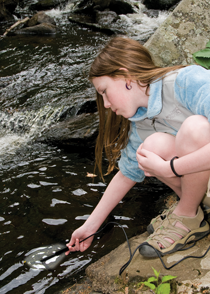Probes Give Students a Sixth Sense

Here’s a riddle: Is there something that you cannot see, touch, smell, taste, or hear?
The answer: Lots! For example, infrared light, blood pressure, CO2 , electric and magnetic fields, voltage, current, and radioactivity. And these are all particularly difficult to teach, in part because students cannot sense them directly and, therefore, lack intuitions about them.
Here’s another riddle: How can we teach about something students cannot see, touch, smell, taste, or hear?
The answer: Use probeware to make any one of these as immediate and intuitive as something they can sense directly.
More questions (hint—the answers involve probeware):
How do I turn a computer into a general-purpose instrument? Use probeware—your computer can become a weather station, data logger, spectrometer, colorimeter, frequency meter, function generator, and much more.
How can I support open-ended student projects that might require measuring almost anything? Stock up on probes. Over 50 are available.
Is a probe-based lab better than an old- fashioned one? It can be—probes can make it possible to focus more on the science, do more experiments, measure more accurately, reduce drudgery, and see results in real time.
For three decades, we’ve been extending students’ senses with probeware. In 1981, Bob Tinker designed the first microcomputer- based real-time temperature data grapher for education, and ignited a whole industry (see Innovator Interview, next page). Now called probeware or simply probes, innovative applications of probes are still an important part of our work and are available from several major vendors. (Visit Probesight, our website dedicated to probes, for research, curriculum ideas, a supplier index, and more.)
Probeware refers to the hardware and software used for real-time data acquisition, display, and analysis with a computer or calculator. If you’re not familiar with probes themselves, think of a supersensitive and lightweight thermometer at the end of a wire attached to the USB port of your computer that delivers immediate and continuous temperature data on a graph. The fast-response or “surface temperature” sensor is one of the easiest to use and one of the most flexible — students can investigate phase change, thermal radiation, or the greenhouse effect, among many other phenomena. (Go to our STEM Resource Finder at concord.org/stem-resources and search for probeware to give it a try.)
The temperature sensor is just one of 50-plus probes available for classroom use. Probes give students new possibilities to explore and understand the world and to see it represented symbolically. Students can capture virtually any kind of data at their fingertips, quickly and easily. And research has demonstrated that probeware can facilitate student learning of complex relationships and can support conceptual change by strengthening student intuitions.
We started a revolution 30 years ago and we’re still innovating. Recently, we solved the “Tower of Babel” problem that meant each vendor’s probes would only run on their software. We created an interface that gives our graphing software access to probes from all the major vendors, so you can mix and match probes. We also combined our probe graphing software with an authoring platform that lets anyone create new learning activities that include probes.
Right now, we’re working on linking probe data with software running in a Web browser, studying “mixed-reality” activities (see page 16) that connect data from hands-on experiments using probes with computer models, and continuing to research new ways probeware can support learning. We’re excited about giving students a sixth sense — and a seventh and eighth, too. The next decades look even more promising for probes.
This material is based upon work supported by the National Science Foundation under Grant No. DUE-1044263. Any opinions, findings, and conclusions or recommendations expressed in this material are those of the author(s) and do not necessarily reflect the views of the National Science Foundation.
Cynthia McIntyre (cmcintyre@concord.org) is director of communications.
Robert Tinker (rtinker@concord.org) is the founder of the Concord Consortium.
